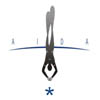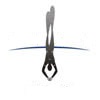|
home
|
APNOEVISION.CH
|
|
|
LAUFEND NEUE KURSE AIDA *Freediver Course Outline
To enrol in the AIDA *Freediver course, an individual must: COURSE PURPOSE
This course is designed to be an introduction to freediving for the
complete beginner. It aims to help the student to develop basic
skills, knowledge and safety procedures necessary to enjoy
freediving safely within the limits of their experience. This course
is not aimed towards competitive freediving but for recreational
freediving only. Therefore the main focus in the course is
freediving without a dive line and without dividing the skills into
different competitive disciplines. The dives can be combinations of
horizontal and vertical swimming. To conduct an AIDA *Freediver
course, the following knowledge development, breath hold exercise
and water session are to be included: KNOWLEDGE DEVELOPMENT This presentation will take place in a classroom-like environment. The knowledge development should be conducted using the AIDA *Freediver Powerpoint slides. AIDA Instructors may supplement these slides with any updated information such as information specific to freediving in the local area.
You may find it useful to have other reference books handy such as
an anatomy atlas, freedive DVDs, magazine articles or reference
books. Students should be provided with a hand-out of the slides to
take away for future reference.
•
Equipment for freediving – introduction to basic freediving
equipment – mask,
•
Breathing for freediving - before a dive and on recovery, correct
breathing and • Equalisation – the need to equalise and basic equalisation techniques • Safety for freediving, avoiding and reacting to blackout and loss of motor control • Freediving and Scuba Diving - combining the two safely • Key rules to remember for freediving safely
All sessions may be conducted on one day however student comfort
should be taken into consideration with special regard to water
temperature, surface conditions and student fatigue. BREATH HOLD EXERCISE (Static apnea) on land and/or in pool/confined water. The student freediver should have access to either a floatation device or pool side to support them at the end of the breath hold if it is done in water. After this session the student freediver will be able to:
•
Demonstrate abdominal breathing and appropriate breathing techniques
in
•
Demonstrate appropriate recovery and breathing techniques at the end
of
•
Demonstrate how to train safely and effectively for static apnea
with a training • Do short breath holds to experience both relaxation and contractions
•
Demonstrate the appropriate rescue technique for a training buddy
experiencing
This session may be conducted in a deep swimming pool or in open
water. The student freediver should have access to either a pool side or floatation device to support them on surfacing. In open water, the maximum depth of the freedives should be fixed by the instructor based on the students’ ability and limited to not more than 10m. The student should use bi-fins for all the dives. After this session the student freediver will be able to:
•
Demonstrate how to prepare and don equipment for freediving. The
student will
•
Demonstrate appropriate breathing techniques with a snorkel during
preparation, • Demonstrate appropriate duck dives
•
If possible (not mandatory) beginning with pull downs – descend
slowly along
•
Demonstrate appropriate bi-finning style and technique with regard
to body • Demonstrate how to freedive safely and effectively with a training buddy
•
Supervise a buddy from the surface as they perform a freedive to a
maximum
•
Demonstrate the appropriate rescue technique of a buddy experiencing
a loss of
Student Equipment – mask, bi-fins, snorkel, appropriate exposure protection, weightbelt Instructor Equipment – mask, bi-fins, snorkel, appropriate exposure protection, weightbelt, stop watch, depth gauge, first aid kit, oxygen administration kit (in countries where this is permitted or required by local law), guideline with bottom plate, and floatation device (if appropriate)
Optional Equipment –underwater
video camera INSTRUCTOR SUPERVISION The AIDA *Freediver course may be conducted by an Active AIDA Instructor with current CPR and First Aid training (completed within the last two years). The instructor should carry liability insurance for teaching freediving.
The maximum student diver-to-instructor ratio for open water
training dives is four students per instructor (4:1). This may rise
to six students per instructor (6:1) when the instructor is assisted
by another freediver qualified to at least AIDA **** level. The
maximum student diver-to-instructor ratio in confined water is eight
students per instructor (8:1). With an AIDA **** Freediver acting as
an Assistant, 4 additional students may be added to this ratio to a
maximum of 12 students. ADMINISTRATION AND PAPERWORK Before commencing any in-water training, each student freediver must complete the following documents, for students aged under 18 years, both must be co-signed by a parent or guardian:
•
AIDA Medical Statement – this must be completed in full with
students marking • AIDA Liability Release or local equivalent
The AIDA Instructor should hold these documents on file for a
minimum of seven years or longer if required by local legislation. CERTIFICATION PROCEDURES
Freedivers who meet all the performance requirements outlined above
may be certified as an AIDA *Freediver. The certification request
should mot be send later than 3 month from the certification date. KEY STANDARDS
Prerequisite certifications: None
AIDA Freediver Kurse
|
||



 AIDA **Freediver
AIDA **Freediver AIDA ***Freediver
AIDA ***Freediver AIDA ****Freediver
AIDA ****Freediver



 AIDA Competiton
Freediver
AIDA Competiton
Freediver

.jpg) Entspannungs-/
Mentaltraining
Entspannungs-/
Mentaltraining